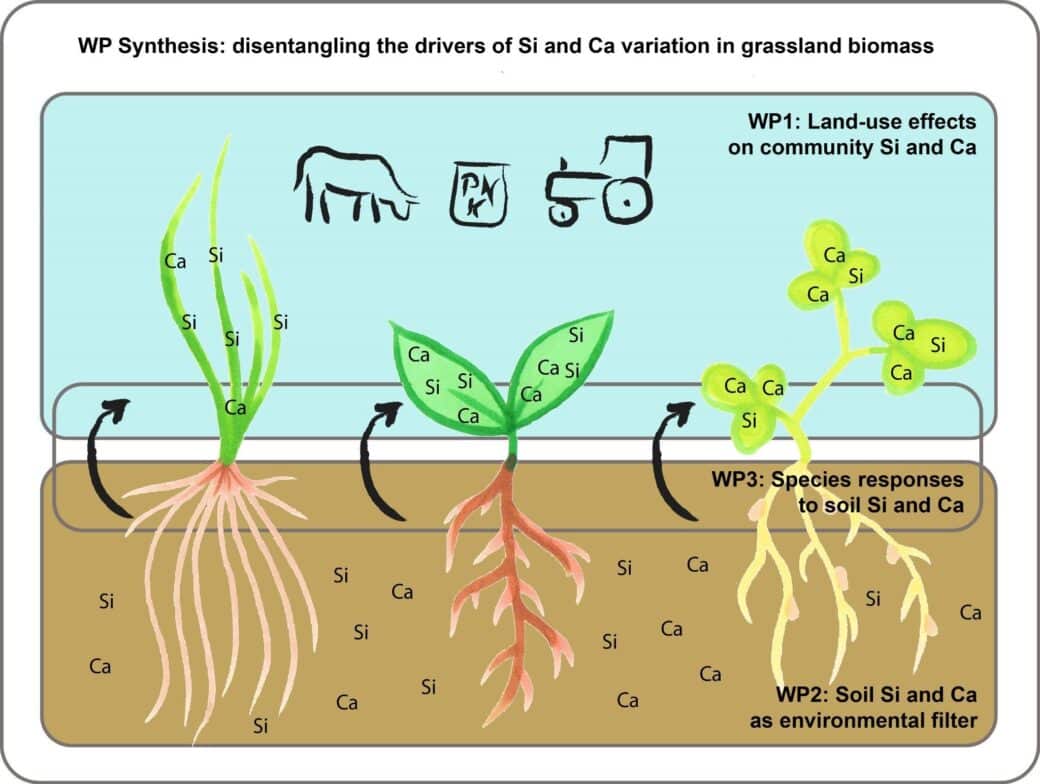Understanding variation of silicon and calcium in managed grasslands

Our aim is to study the various mechanisms leading to variation in Si and Ca with effects on biodiversity and ecosystem functioning in managed grasslands. Grasses are Si and legumes are Ca accumulator plants. Hence, biodiversity and abundance of a certain plant functional type (PFT) is largely altering the biomass Si and Ca concentrations. We aim to disentangle the effect of land-use on plant community Si and Ca (objective 1), from the filtering effect of soil Si and Ca via shifts in species composition (objective 2) and the environmental effect of soil Si and Ca availability on plastic variation in different species and PFTs (objective 3). We ultimately aim to understand the causal relationships that lead to variation in aboveground biomass Si and Ca in managed grasslands (objective 4).
- How does land-use and its various aspects influence community-biomass Si and Ca?
- How does soil Si and Ca filter for plant community functional traits and PFTs?
- How do species Si and Ca plastically respond to soil Si and Ca?
- What are the causal relationships that lead to variation in aboveground biomass Si and Ca in managed grasslands?
Hypothesis (WP1): We expect land use – specifically mowing and grazing – to change the community-biomass concentration of Si and Ca by a decrease of Si in the biomass for plots where biomass was removed over a longer time-span.
Hypothesis (WP2): Based on specific needs of the different PFTs, we expect opposing effects along Si- and Ca-availability gradients in the field. Under low soil Si and high Ca availability legumes may be more abundant whereas under high Si and low Ca availability grasses may dominate. We expect forbs to show less distinct type-specific patterns but to be filtered for depending on their species specific requirements. Furthermore, we hypothesize a community mean functional shift towards ‘outsourcing’ and ‘fast’ strategies under high Ca availability due to a higher amount of legumes that show the respective strategies (Bergmann et al., 2020). An increase in Si availability might lead to a shift towards ‘do-it-yourself’ and ‘slow’ if grasses get more dominant and hence more Si is utilized for herbivore defense linking above- and belowground economy (Weigelt et al., 2021).
Hypothesis (WP3): We expect species Si and Ca to be positively correlated to soil Si and Ca availability in all PFTs. We further expect a more pronounced effect of elemental limitation in PFTs that have a higher elemental demand. Hence, grasses should show more plasticity in biomass Si in response to soil Si while legumes should show more plasticity in biomass Ca in response to soil Ca. Forbs should show different effects depending on their Si and Ca demand. We further expect an overall intraspecific shift towards a ‘slow’ strategy with soil Si and await this effect to be most pronounced in grasses.
Hypothesis (WP Synthesis): We cannot predict the strength of relationships beforehand but based on the aforementioned mechanisms we hypothesize that land-use will have direct effects on the proportion of PFTs or the community mean functional traits as well as on soil Si and Ca. Soil Si and Ca will further affect the proportion of PFTs or the community mean functional traits as well as their biomass Si and Ca. All these variables will have direct or indirect effects on community biomass Si and Ca.
The four work packages and their contribution to the overall aims of the project is illustrated in Figure 1.
WP1 – Si and Ca analyses in plant biomass at community level: Analyses will be carried out on EP-plot level (n=150) and compared with NIRS data later on. We will extract plant Si concentration by alkaline extraction of ground plant material and plant Ca concentration will be extracted by a closed vessel microwave digestion system.
WP2 – soil analyses regarding plant available Si and Ca on REX1 level: Soil of all REX1 plots will be analyzed (n =45). We will extract available Ca using the Mehlich III method. To quantify available Si in soils, we will run soil CaCl2 extraction. In addition to this, we will analyze Si also in the Mehlich III extracts as this is an alternative method to quantify Si availability in soils.
WP3 – Si and Ca analyses in plant biomass at species level: We will determine Si and Ca on individual level for the 12 species and with a replication of 3 per plot where the species occurs. This will lead to ~800 plant samples for two different types of extractions and analysis.
WP4 – disentangling the drivers of Si and Ca variation in grassland biomass:
Using structural equation modeling (SEM) we will test the underlying mechanisms of land-use effects on community biomass Si and Ca content. Specifically, SEM will allow us to disentangle the direct land-use effects and indirect effects mediated by altered community composition (i.e., fraction of grasses, forbs and legumes or functional trait shifts) and/or through plastic variation in Si and Ca of each functional group.
We will use land-use information (WP1), vegetation data and community Si and Ca (WP1) of the 45 EPs corresponding to the REX1 level. Soil Si and Ca data will be used from the corresponding REX1 sampling (WP2) and information on PFT-specific plastic response in Si and Ca will be used from WP3.









